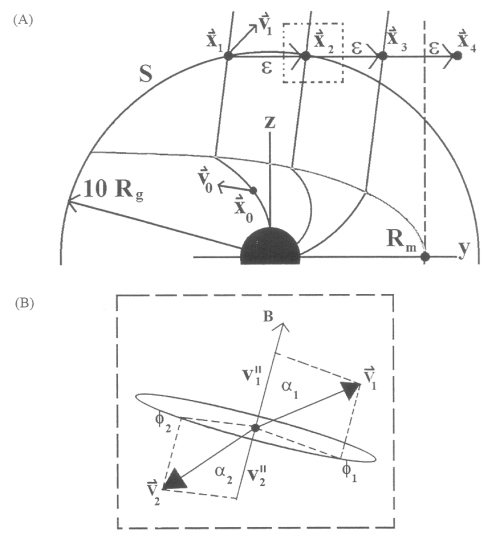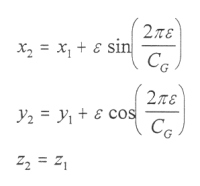Investigation of the Magnetosphere of Ganymede with Galileo's Energetic Particle Detector
Ph.D. dissertation by Shawn M. Stone, University of Kansas,
1999.
Copyright 1999 by Shawn M. Stone. Used with permission.
5.2.2 Trace Criteria
The trajectories of the particles are traced as they gyrate and translate through the magnetosphere of Ganymede. If the particle happens to hit Ganymede during its motion it is removed from the distribution, and the simulation proceeds on to the next particle. However, not all particles will have the correct pitch angle to fall into the loss cone of Ganymede or have the right phase properties to hit it. It is then necessary to enforce limits on the length of time and distance that the particles are followed. To handle this, Particle_Follow runs in two modes: one shot mode and extended bounce mode.
When the simulation is in one shot mode the particle is traced until it leaves a spherical volume of 10 Rg (denoted from this point on as boundary S) as shown in Figure 5.6 for trajectory a. Particles that have flat pitches (close to or equal to p/2), as trajectory b, have little or no motion along the magnetic field line and will tend to remain within the 10 Rg volume. It is then necessary to enforce a time limit on the trace time of the particles. The trace time is based on the gyroperiod of a charged particle in a 100 nT field, which is the value of the Jovian background field at the orbit of Ganymede. Utilizing Equation [2.4] the gyroperiod of an electron in this field is 3.5 x 10-4 s and 6.4 x 10-1 s for ions (Z=1). The maximum trace time of 3s for the electrons and 150s for the ions is deemed adequate in one shot mode. This allows for 8.57 x 103 gyrations for electrons and 235 gyrations for ions.
 |
Figure 5.6 Schematic of the spherical volume, denoted as boundary S, where particles are traced by the integration of the Lorentz force equation. In one shot mode, particles that leave S are not traced and the simulation moves on to the next trajectory, or exits completely if finished. Trajectory a has a pitch angle that will allow it to leave S. However, trajectory b has a flat pitch and will tend to gyrate within S. It is then necessary to put a time limit on the time reversed tracing of particles. |
In extended bounce mode, the possibility that the particles can interact more than once with Ganymede is considered. It is not feasible to integrate the Lorentz force equation along the Jupiter field line to the particles’ Jupiter bounce point; it would just take too long. An approximate method is then enforced. Particles that leave the boundary S are advanced in the anti-corotation (time reversed) direction by a distance e = tBncorotation where tB is the bounce time to the Jupiter mirror point and back and ncorotation is the velocity of corotation. Figure 5.7a shows the physical situation. The formula in GSII coordinates is
|
[5.7] |
where CG = 6.97 x 106 km is the circumference of the Ganymede orbit at 15 Rj. From position 1, where the particle leaves the bound sphere, the state of the particle is translated to position 2. At this point, the velocity parallel with the magnetic field line is reversed and the phase of the particle is randomized within 2p (conserving the particles’ energy), as shown in Figure 5.7b. The particle is then allowed to interact with the magnetosphere of Ganymede again. If the particle then bounces out of the sphere again, the process is repeated at points 2 and 3 until the particle convects past the Ganymede interaction region at position 4 or is absorbed by Ganymede. This distance depends on the specific model and encounter; Table 5.1 shows these distances.
Figure 5.7 (A) Representation of the advancement of the electrons in extended bounce mode. An electron that begins its time reversed motion at x0 with a velocity n0 will exit S at x1. At that point the electron is advanced in the anti-corotation direction by an amount e, which depends on the half bounce time between the Jupiter bounce point and Ganymede and the value of the corotation velocity used. (B) The electron is then reintroduced into the simulation by reversing the component of the velocity n1 parallel to the magnetic field and then randomizing the phase of the perpendicular component. The result is the new state of the bounced particle x2,n2, where a1 = a2 and energy is conserved.

Table 5.1 The Rm values in Rg beyond which particles in extended bound mode are considered to have convected past the Ganymede interation region. The values are based on the region where Jovian field lines no longer connect to Ganymede.
| Encounter/Model | M1 | M2 |
| G2 | 2.0 | 2.0 |
| G7 | 2.0 | 2.6 |
The time limits for the particles in extended bounce mode are the same as in one shot mode but do not include the half bounce time (only the time they are traced within S). The bounce times tB are calculated by the numerical integration of Equation [2.26] in a Jovian field based on the O6 model. The bounce times for the electron channels for G2 and G7 are displayed in Table 5.2. The ions are not considered in extended bounce mode since the smallest bounce time for channel A7 is around 90s, which puts it 4 Rg beyond the Rm boundary.
Table 5.2 Bounce times between the Ganymede region and the Jupiter bounce point for electrons. The difference in bounce times between encounters is due to the fact that at G2 Ganymede was above the plasma sheet and was below for G7.
| Channel | G2 Time (s) | G7 Time (s) |
| E0 | 30.2 | 33.3 |
| E1 | 23.86 | 26.33 |
| E2 | 20.7 | 22.8 |
| E3 | 17.33 | 19.1 |
| F0 | 13.6 | 15.0 |
| F1 | 11.55 | 12.72 |
| F2 | 10.12 | 11.14 |
| F3 | 9.36 | 10.32 |
Next: 5.3 Implementation of Pitch Angle Scattering
Return to dissertation table of contents page.
Return to main
Galileo Table of Contents Page.
Return to Fundamental
Technologies Home Page.
Updated 8/23/19, Cameron Crane
QUICK FACTS
Mission Duration: Galileo was planned to have a mission duration of around 8 years, but was kept in operation for 13 years, 11 months, and 3 days, until it was destroyed in a controlled impact with Jupiter on September 21, 2003.
Destination: Galileo's destination was Jupiter and its moons, which it orbitted for 7 years, 9 months, and 13 days.




